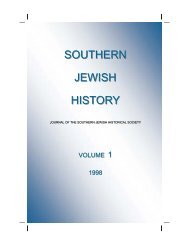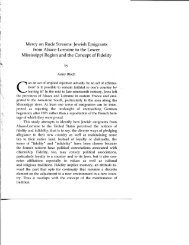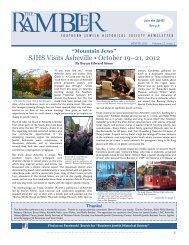A Shtetl Grew in Bessemer - Southern Jewish Historical Society
A Shtetl Grew in Bessemer - Southern Jewish Historical Society
A Shtetl Grew in Bessemer - Southern Jewish Historical Society
Create successful ePaper yourself
Turn your PDF publications into a flip-book with our unique Google optimized e-Paper software.
BARR/A SHTETL GREW IN BESSEMER 11<br />
congregation began <strong>in</strong> 1891, the article <strong>in</strong>dicates that “of those<br />
present at that memorable occasion, only Mrs. H. Goldberg, the<br />
wife of one of the founders, is still liv<strong>in</strong>g <strong>in</strong> <strong>Bessemer</strong> today. Mrs.<br />
Goldberg well remembers the thrill she experienced at that time,<br />
know<strong>in</strong>g that the young village of <strong>Bessemer</strong>, founded only three<br />
years previously [the city found<strong>in</strong>g actually occurred four years<br />
earlier (1887)] was go<strong>in</strong>g to have its own <strong>Jewish</strong> congregation. The<br />
follow<strong>in</strong>g year [1892], the small group of pioneer settlers secured a<br />
plot of land for a cemetery, and <strong>in</strong> 1894, Mrs. Goldberg remembers<br />
hav<strong>in</strong>g been a member of a delegation, which secured from the<br />
<strong>Bessemer</strong> Land Company the site on which two years later the<br />
temple was built. The congregation grew slowly until <strong>in</strong> the 1920s<br />
it numbered more than 70 families.” 47 Department store owner<br />
Samuel Erlick was elected its first president. 48<br />
While the temple’s life span covered some seventy-eight<br />
years, for only ten of those did it susta<strong>in</strong> a regular rabbi, with<br />
Gall<strong>in</strong>ger serv<strong>in</strong>g the bulk of those years from 1948 to 1957. Apparently<br />
a Rabbi Hirsch, who served from 1917 to 1918, may have<br />
been the first full-time rabb<strong>in</strong>ical leader. 49<br />
Without a regular rabbi, services <strong>in</strong> <strong>Bessemer</strong> were conf<strong>in</strong>ed<br />
ma<strong>in</strong>ly to the High Holidays and to irregular Friday nights. Temple<br />
Beth-El employed rabb<strong>in</strong>ical students from Hebrew Union<br />
College <strong>in</strong> C<strong>in</strong>c<strong>in</strong>nati to lead High Holiday services and for life<br />
cycle events dur<strong>in</strong>g its early years. 50 S<strong>in</strong>ce Birm<strong>in</strong>gham was a<br />
short distance away, rabbis from that city traveled to <strong>Bessemer</strong> at<br />
special occasions to officiate. Often, lay readers, like shoe store<br />
owner Urias Schwabacher, conducted services. 51<br />
In these early days Temple Beth-El’s members followed either<br />
Reform or Orthodox traditions. While most of the <strong>Jewish</strong><br />
people <strong>in</strong>terviewed for this project are either Reform or Conservative<br />
now, their memories of Temple Beth-El are of an <strong>in</strong>stitution<br />
that through the 1950s was either primarily Orthodox or whose<br />
services were ma<strong>in</strong>ly dom<strong>in</strong>ated by the Orthodox members. The<br />
denom<strong>in</strong>ational tendency reflected the eastern European background<br />
of a majority these congregants, a majority augmented by<br />
another <strong>in</strong>flux of immigrants <strong>in</strong> 1899. 52 Arnold Lefkovits, whose<br />
Hungarian-born grandfather was one of the temple’s organizers,







